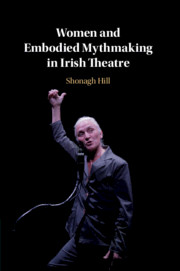Book contents
- Women and Embodied Mythmaking in Irish Theatre
- Women and Embodied Mythmaking in Irish Theatre
- Copyright page
- Dedication
- Contents
- Acknowledgements
- Introduction: A Creative Female Corporeality
- Chapter 1 Revolutionary Bodies: Mythmaking and Irish Feminisms
- Chapter 2 Unhomely Bodies: Transforming Space
- Chapter 3 Metamorphic ‘Bodies That Matter’: Process and Resistance
- Chapter 4 Staging Female Death: Sacrificial and Dying Bodies
- Chapter 5 Haunted Bodies and Violent Pasts
- Chapter 6 Olwen Fouéré’s Corpus: The Performer’s Body and Her Body of Work
- Bibliography
- Index
Chapter 6 - Olwen Fouéré’s Corpus: The Performer’s Body and Her Body of Work
Published online by Cambridge University Press: 29 August 2019
- Women and Embodied Mythmaking in Irish Theatre
- Women and Embodied Mythmaking in Irish Theatre
- Copyright page
- Dedication
- Contents
- Acknowledgements
- Introduction: A Creative Female Corporeality
- Chapter 1 Revolutionary Bodies: Mythmaking and Irish Feminisms
- Chapter 2 Unhomely Bodies: Transforming Space
- Chapter 3 Metamorphic ‘Bodies That Matter’: Process and Resistance
- Chapter 4 Staging Female Death: Sacrificial and Dying Bodies
- Chapter 5 Haunted Bodies and Violent Pasts
- Chapter 6 Olwen Fouéré’s Corpus: The Performer’s Body and Her Body of Work
- Bibliography
- Index
Summary
This chapter explores how Olwen Fouéré’s Sodome, my Love (2010) and riverrun (2013), address the disparity between the fixity of mythic ‘woman’ and the complexity of actual women, through the performing body. Susan Leigh Foster’s ‘claim for a writing-dancing body’ enables examination of Fouéré’s corporeal intervention in the cultural production of myths of femininity; a writing body inscribed by an archive of myths of femininity but also generating other possibilities. The chapter utilizes Jean-Luc Nancy’s work in Corpus to enable examination of that which is beyond inscription: the excluded creative female body as the other edge of signification. Fouéré’s corpus draws attention to the transformative process of writing the body and of self-sculpting to explore women’s exscribed-being and thereby intervenes in the performative reassertion of limiting myths of femininity which silence a desiring and creative female corporeality. The chapter concludes that the corpus of women’s mythmaking in Irish theatre, the genealogy proposed by this book, articulates the exscribed edge of women’s corporealities.
- Type
- Chapter
- Information
- Women and Embodied Mythmaking in Irish Theatre , pp. 213 - 236Publisher: Cambridge University PressPrint publication year: 2019

